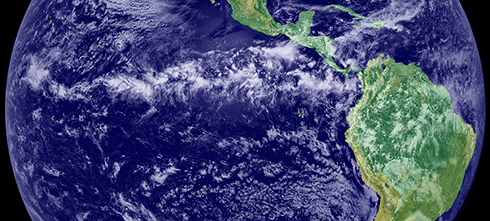
|
Published: 17 February 2014
Strong east-west trades may have slowed global warming
The ‘pause’ in global warming since 2001 can be explained by the discovery of unusually strong winds in the Pacific, climatologists have found.

|
| The band of bright white clouds near the Equator show where the trade winds of the Northern and Southern Hemispheres come together. |
Global surface air temperatures have more or less flatlined since the turn of the century, prompting some observers to claim that the planetary warming trend has stopped. But the new research, just published in Nature Climate Change, shows how stronger winds have driven the excess heat down into the ocean.
Researchers led by Matthew England, a professor of climatology at the University of New South Wales, began by looking at the differences between the 1990s, when Earth’s surface was strongly warming, and the 2000s, after the hiatus began.
Previous research has already shown that cooler temperatures over the eastern Pacific are linked to a slowdown in worldwide warming, but researchers wanted to know why.
Data from ships and weather buoys revealed an unusual strengthening of the Pacific trade winds, which blow east-to-west near the Equator. In turn, that speeds up the ‘overturning circulation’ of Pacific waters, driving warmer water down to depths of up to 300 metres in the western Pacific, while cooler water wells up in the ocean’s east.
When plugged into climate models, the effect of the strengthened winds is equivalent to 0.1–0.2°C of surface cooling – which accounts for almost all of the observed slowdown in global surface temperatures.
Previous climate models missed this effect because the strong winds had never been observed before, Professor England said.
‘The models are improving all the time, but in this case they did not capture the dramatic observed wind trend.
It is unclear exactly what has driven the upswing in wind intensity, the researchers said. It could be natural variation, or driven by another climate factor such as the warming of the adjoining Indian Ocean.
Professor England said it will be difficult to predict when the strengthened winds will ease. But when they do, the world is likely to see a resumption of warming air temperatures.
‘That’s a very important thing to keep track of and we need to keep making measurements of the oceans, to be sure to detect the first signs of when this change occurs.’
Steve Rintoul, a researcher with the CSIRO’s Marine and Atmospheric Research, said: ‘More than 93 per cent of the warming of the planet since 1970 is found in the ocean, according to a recent IPCC report.
‘If we want to understand and track the evolution of climate change, we therefore need to look in the oceans. The oceans have continued to warm unabated, even during the recent ‘hiatus’ in warming of surface temperature.’
Professor England said his results fit with the observation that global surface warming can be held in check for a decade or two by the Pacific Ocean entering a ‘negative phase’ of what is known as the Interdecadal Pacific Oscillation. As is occurring now, this state is characterised by cooler surface temperatures in the eastern Pacific, and has been associated with previous historical periods when planetary warming has stalled, such as the 1940s to 1970s.
‘We should be very clear: the current hiatus offers no comfort – we are just seeing another pause in warming before the next inevitable rise in global temperatures,’ Professor England said.
Source: The Conversation



